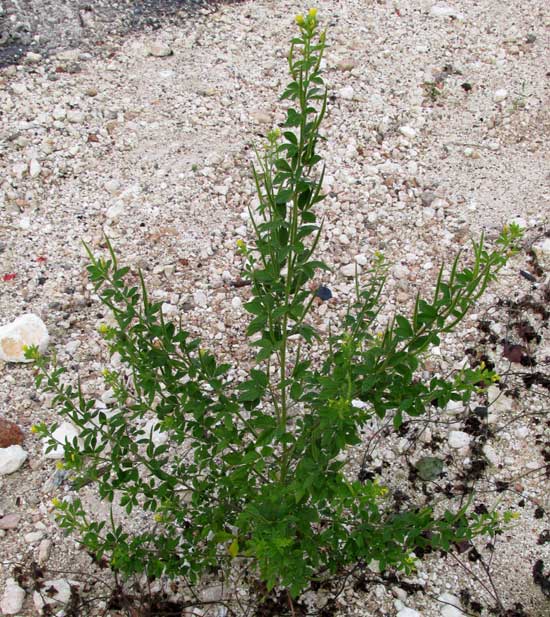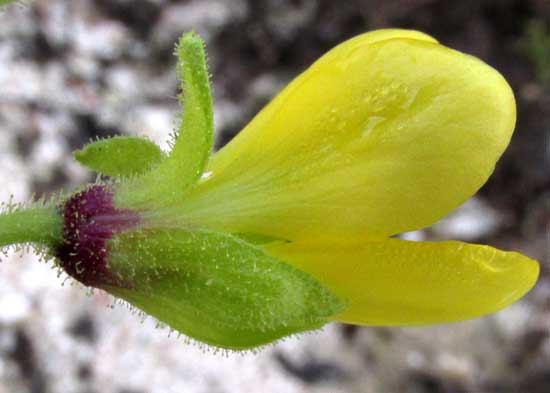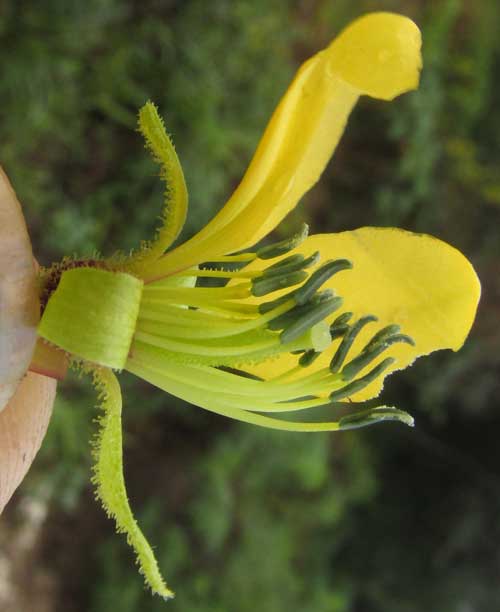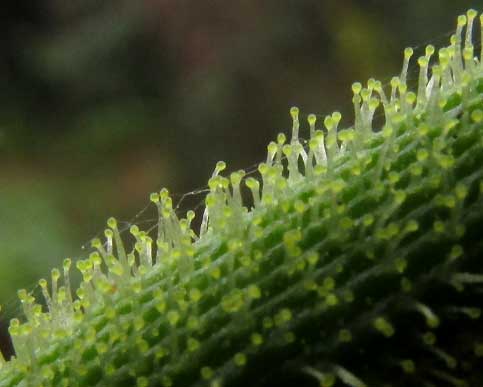Excerpts from Jim Conrad's
Naturalist Newsletter
from the January 17, 2016 Newsletter issued from Hacienda Chichen Resort beside Chichén Itzá Ruins, central Yucatán, MÉXICO
ASIAN SPIDERFLOWER
As I biked toward Pisté to buy bananas a weed beside the road caught my attention because it was the only plant growing in loose gravel dumped there just a few weeks ago when they widened the highway. With the advent of the dry season, some morning glories who had grown onto the area were dead from lack of rain, but this weed -- obviously a tough one with fast-growing, deep roots -- looked positively perky, as shown below:

Up closer the trifoliate leaves looked like they belonged in the Bean Family, and the yellow flowers at first glance could have been those of the big genus Senna, plus the slender, upward-pointing fruits could have been legumes, as you can see above.
Up closer still, the bilaterally symmetrical corolla kept reminding me of Senna, but the green vegetative parts turned out to be heavily invested with sticky, gland-tipped hairs, shown below:

Of all the Bean Family members we've run across through the years, I couldn't remember any with such sticky hairs. The side petals of a flower were removed to see what the sexual parts looked like, as shown below:

Bean Family flowers often have ten stamens with their filaments united into a cylinder around the style, but this blossom contains more than ten stamens and their filaments aren't connected. Also, once I touched the plant, the air around me was suffused with a powerful medicinal odor unlike any I've encountered in the Bean Family. This was not a member of the Bean Family.
A close look at the fruits confirmed this. Bean Family legumes normally are flatish, and open along one margin to release the beans. This plant's fruits were round in cross-section and marked with many tiny ridges running its length. Below you can see the fruit's ridges and gland-tipped hairs:

Once the Bean Family was rejected, I finally remembered that here we've encountered something with fruits more or less like these, the very hairy, medicinal African Spiderflower, Cleome gynandra, profiled at www.backyardnature.net/yucatan/african.htm.
Checking to see if other Cleome species were listed for the Yucatan, I was led to our plant: It's CLEOME VISCOSA, known by many names, including Asian Spiderflower, Wild Mustard, Yellow Cleome and Tickweed. Native to southeastern Asia and Africa, one reason for its many names is its large distribution area, being invasive from the US south through Mexico, Central and South America, and the Caribbean area.
Our roadside Asian Spiderflower's strong medicinal smell had prepared me for finding that the plant is recognized worldwide for its healing properties.
In fact, in a 2004 study by RR Jane and SD Patil, entitled "Cleome viscosa: An Effective Medicinal Herb for Otitis Media," we're told that the whole herb is used in treatment of inflammation of the middle ear, or Otitis Media, and applied on wounds and ulcers. Asian Spiderflower's leaves and seeds also are used to treat infections, fever and headache. Otitis Media is recognized as the leading cause of death in critically ill patients in developing countries.
A tea of the plant is used as an expectorant and to stimulate digestion, and steam off water in which the whole plant is being boiled is inhaled to treat headaches. Other uses are described as well.
So, what are you to think of an aggressive weed from Asia invading our area, offering these cures in a world where most people can't afford commercial medicines?
For my part, I was glad to meet the plant and as soon as the fruits ripen I plan to collect seeds to have plants ready for my regular bouts with middle ear infections when the rainy season returns.
By the way, though most authorities refer to our plant as Cleome viscosa, the Flora of North America lists it as Arivela viscosa. It's a member of the newly erected Spiderwort Family, the Cleomaceae.
from the March 6, 2016 Newsletter issued from Hacienda Chichen Resort beside Chichén Itzá Ruins, central Yucatán, MÉXICO
GATHERING ASIAN SPIDERFLOWER SEEDS
In January we found that Asian Spiderflowers are noted for their medicinal properties, especially in treating ear problems. During the rainy season here I always get an ear fungus, so this week returned to the same plant visited earlier and was pleased to find it bristling with mature, upward-pointing, capsular-type fruits with their tips open, spilling out tiny, black seeds. You can see the fruits below:

I've stored the seeds in a nifty mouse-proof metal box Bea from Ontario left after her recent visit and plan to greet the rainy season in late May with plenty of young Asian Spiderflowers on hand.